Alimentador de taxa variável

Content
Alimentadores de correia vs. transportadores de correia
Na forma e na função, os alimentadores de correia são essencialmente transportadores de correia curta. Existem algumas áreas importantes em que os dois diferem, no entanto:
Rate control: feeders are capable of rate control (meaning the rate at which they operate can be varied), while conveyors operate at a constant speed.Operational speed: feeders typically operate at slower speeds than belt conveyors.Flow patterns: feeders are flood-loaded (where all of the material in the bin is in motion during withdrawal), while belt conveyors are funnel-loaded (where some of the material in a bin moves while the rest remains stationary).Indústrias
Mining / power generation. Due to rugged design and the ability to continuously move material in low-headroom situations, belt feeders have proven ideal for handling materials like coal and ore. This gentle and economical transportation has proven vital for both the mining and power generation industries.Bulk material handling. Belt feeders are typically used for handling fairly light, fine, abrasive, free flowing materials. Feeder units are typically placed under storage facilities such as silos, surge hoppers or load hoppers, and may be operated either horizontally or on an incline to save headroom. For such applications, belt width is governed by the size of the material being handled and required tons per hour.Mecanismos de transporte
São utilizadas várias técnicas e mecanismos de transporte diferentes, mas essas dividem amplamente nessas categorias, em ordem decrescente de precisão:
closed-loop feedback systems, where the output from some variable feeder is measured and the feed rate varied by a local control system ensuring the desired rate is maintained. To be noted that the dosing equipment can be a belt but can also be a screw conveyor, a twin screw conveyors or a vibrating tubevolumetric feeders, such as screw conveyors, delivering a predictable volumetric feed, driven at a variable rateopen loop systems where a feeder (e.g. a belt feeder) is driven at a given rate which has been established in advanceopen loop systems where a door or valve on a feed hopper is opened by a graduated amount, delivering an approximate rate of feedQualquer uma delas pode ser combinada com verificações subsequentes de Beltweighers ou (no caso de grãos, pós e líquidos) medidores de fluxo para fornecer um fluxo de material mais preciso.






